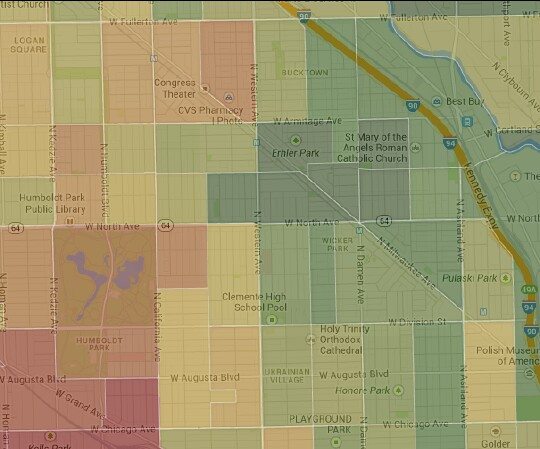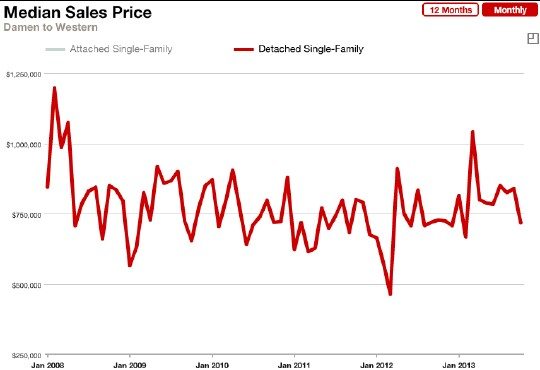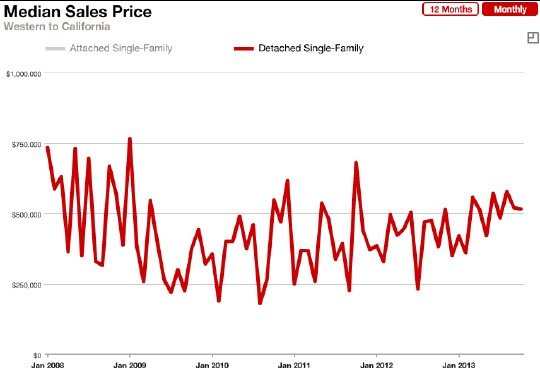It’s as if there is an invisible wall running through the middle of Chicago, along Western Avenue all the way south of Montrose. When buyers of million dollar homes specify their search criteria they will often specify that they want to stay east of Western Avenue – or if they specify Ukrainian Village, Bucktown, Wicker Park, Roscoe Village, or St. Ben’s those neighborhoods technically stop at Western Avenue so again you are staying east of Western. And it almost doesn’t matter anyway because over the last 7 years there have been very few homes above $1 MM for sale west of Western anyway as you can see in the map below. It’s pretty dramatic isn’t it?
In this map I just looked at home sales west of Ashland to reduce the data points and the sales for each of the last 7 years are color coded. In fact you can turn on or off any particular year by checking different boxes at the bottom of the map. And you can go here to see a full sized version of the map: Million Dollar Homes West Of Ashland.
It really is like there is a force field at Western that prevents million dollar homes from being built and sold on the west side – with a few exceptions. North of Montrose there are many more million dollar homes being sold past California even. Why north of Montrose? Because the brown line runs through that area making it a lot more valuable. And there is also a higher concentration of million dollar homes along the Kennedy and blue line – again because of the value of easy access to transportation.
So Western Avenue is almost like the proverbial railroad tracks – except it’s not quite like the West side is undesirable. It’s just that the houses there tend to be less expensive. So what’s magic about Western Avenue? What happens as you cross the street? And why do all those neighborhoods dead end at Western Avenue? Which came first the neighborhood definitions or the community differences? I haven’t lived in Chicago long enough to know the ancient history so if you know you can fill me in. I do know that the area where Lane Tech is today used to be Riverview but that was a long time ago.
Well, for one you are typically getting further away from public transportation options as you move west. But then again public transportation isn’t really that much more accessible just east of Western than it is just west of Western. If you can’t walk to the el stop in 10 minutes in January you may not feel like you have good access to public transportation regardless of which side of Western you live on.
The other thing that happens as you cross Western Avenue is that you cross into a few lower income census tracts. For example if you look at the heat map from RichBlocksPoorBlocks.com you will see that there are are a few sections of Western Avenue where the median household income drops pretty dramatically as you cross the street. In the map below as the color transitions to darker green median household income goes up and as it transitions to darker red it goes down. From Fullerton to Armitage the median income is $66K on the east side of the street but $35K on the west side of the street. And from Armitage to Bloomingdale it’s $107K vs. $66K. And then from Division to Chicago it’s $67K vs. $42K.
So will this Western Avenue barrier ever be breached? There was a time when people wouldn’t cross Ashland (some still won’t) and then they wouldn’t cross Damen. And you would think that basic economics would dictate that the disparity between one side of the street and the other can’t grow indefinitely.
Well, let’s look at the data. First, I looked at the distribution of the million dollar plus homes west of Ashland to see if there is any evidence of the concentration of these homes drifting westward over the last 7 years. There is no such evidence. They’ve pretty much remained centered right around Damen Avenue.
Then I looked at the trend in median prices of single family homes on each side of Chicago’s Iron Curtain but remember that this doesn’t necessarily tell us what is happening with home prices but it usually does tell us what is happening with the mix of properties sold. First, let’s look at the slice south of Montrose to Grand from Damen to Western:
Median home prices just east of Western used to be around $1 MM but fell dramatically as the home bubble burst. More recently they are drifting ever so slightly upward but are hovering just a tad above $750K.
And if we look at the same vertical slice between Western and California we see that the median price never really went above $750K, did drop down fairly dramatically, but is now just as dramatically rising and is currently hovering around $500K.
There is no question that eventually the area west of Western will become populated with million dollar plus homes but at that point the disparity between the east and west sides of the street may persist and the east side may just be populated with homes priced well above $1 MM. And, regardless, it looks like that day is still several years into the future. In the meantime, if you are willing to be a pioneer you can definitely find cheaper living just a couple of blocks further west.
If you want to keep up to date on the Chicago real estate market, get an insider’s view of the seamy underbelly of the real estate industry, or you just think I’m the next Kurt Vonnegut you can Subscribe to Getting Real by Email. Please be sure to verify your email address when you receive the verification notice.


